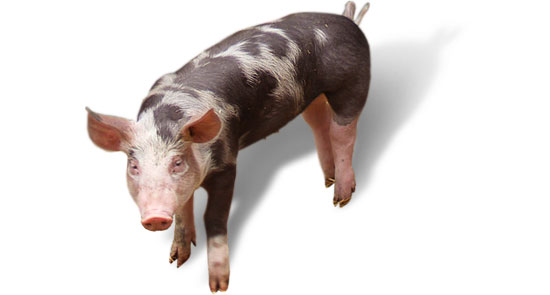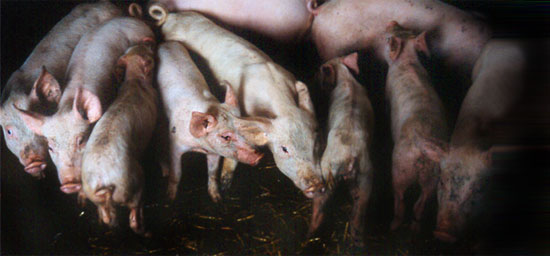One of the earliest reports was from France where it was reported that pigs derived from the Pietrain breed had a lower susceptibility to develop PMWS than pigs derived from either Large Whites or Landrace. However, this was not confirmed in a later larger study carried out by the same research group. They reported on four PMWS affected farms which had used random semen for mating from Pietrain and non-Pietrain boars and found that the PCVAD in the Pietrain offspring did not differ from that observed in other genotypes in terms of PCV2 seroconversion, morbidity, and mortality.

Figure 1. Genotype differences? Is the Pietrain protective?
In a trial in the US, PCV2 susceptibility was studied between small numbers of Landrace and Pietrain pigs under experimental conditions where the pigs were inoculated with PCV2 isolate ISU-40895. Onset of seroconversion and concentrations of anti-PCV2-IgM, anti-PCV2-IgG, and anti-PCV2 neutralizing antibodies were similar in Landrace-PCV2 and Pietrain-PCV2 groups. Furthermore, the amount of PCV2 DNA and cytokine concentrations in serum and plasma samples were not different between the 2 PCV2-inoculated groups. However, Landrace-PCV2 pigs had significantly more severe lymphoid lesions than the Pietrain-PCV2 pigs.
Another small-scale US study reported on genetic differences in the susceptibility to PCVAD in Duroc, Landrace and Large White pigs which were infected intranasally and intramuscularly at 5-7 weeks of age with PCV2. Although PCV2-associated lymphoid depletion and granulomatous inflammation were observed in pigs of all breeds, clinical disease compatible with PMWS was observed only in the Landrace pigs.
Spanish workers reported on a large scale study in two farms which had 100% Pietrain, 50% Pietrain and 0% Pietrain genotypes. They showed that the expression of PCVAD was related to the percentage of Pietrain genes with the 0% genotype having the highest mortality. However, the authors warned that the results should be treated with caution as the reported differences might have been related to certain individuals and/or certain lines rather than related to a specific breed.
In the UK, a survey across 145 farms reported that the presence of PCV2 antibodies was strongly associated with the genetic background. Here the Hampshire breed was identified as ‘protective’.
The conclusion from the above is that there are indications of genotype differences in PCVAD with the Landrace the most susceptible of major breeds.

Figure 2. PCVAD – Long term breeding plans? (J. Mackinnon)
However, the real challenge for the future is to discover whether it will be possible to develop breeding techniques that have the potential to lower the incidence across genotypes. Recent results from the University of Nebraska are particularly interesting as the heritabilities of PCVAD score, PCV2 viraemia and antibody levels at 90 days of age were 0.16, 0.38 and 0.55 respectively. These indicate that resistance to PCV2 and reduced incidence of PCVAD through selection are possible. If selection was practiced in nucleus breeding populations then resistance would be transmitted through the breeding pyramid to commercial producers. Unfortunately, this strategy would take many generations of selection. In addition, all pigs in the nucleus populations would have to be exposed to PCV2!
Another approach, using gene array analysis, would be to study PMWS-affected pigs and non-affected littermates (who share at least 50% of their genes in common) to identify gene loci with differences in expression that may be responsible for increased susceptibility to PCVAD.
Following the publication of the draft pig genome last November the most effective long-term selection strategy may be to us genomic selection for resistance to PCV2 and decreased incidence of PCVAD. As soon as marker panels with known relationships with response variables are available, it will be possible to practice selection in a population without the need for PCV2 exposure.




